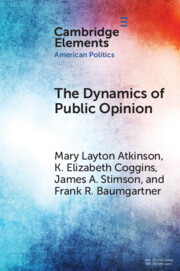Element contents
The Dynamics of Public Opinion
Published online by Cambridge University Press: 20 September 2021
Summary
- Type
- Element
- Information
- Series: Elements in American PoliticsOnline ISBN: 9781108871266Publisher: Cambridge University PressPrint publication: 11 November 2021
References
- 10
- Cited by



